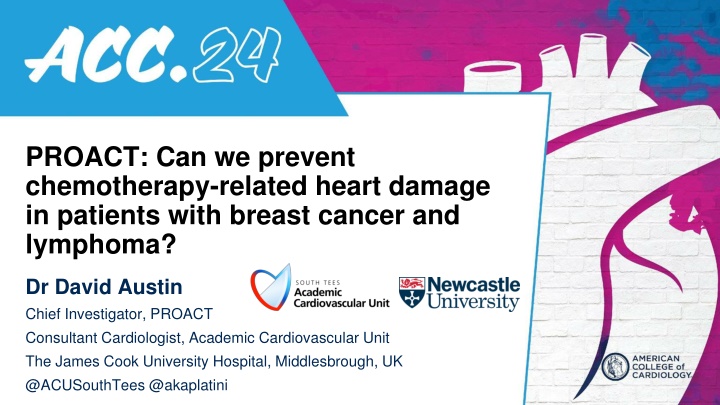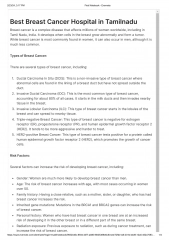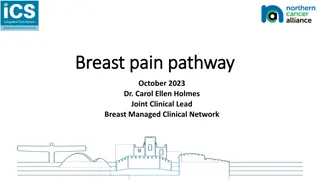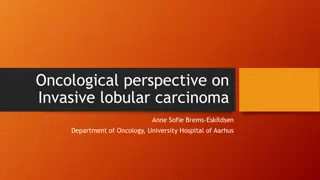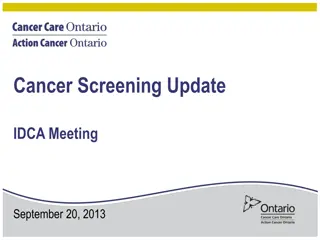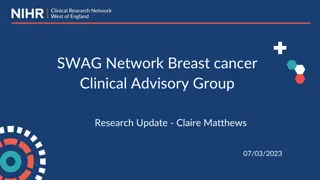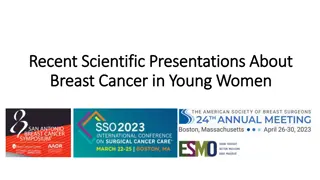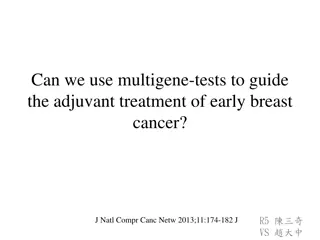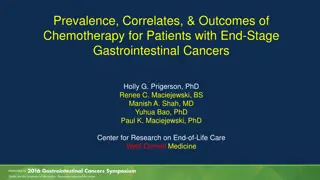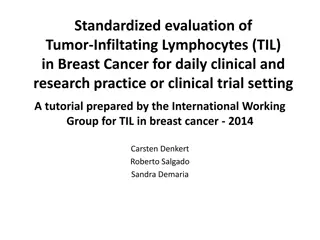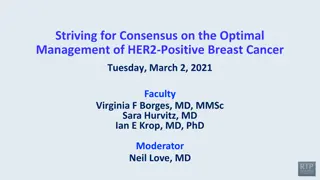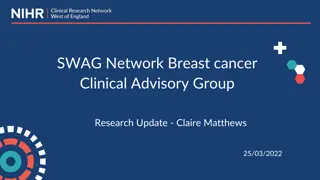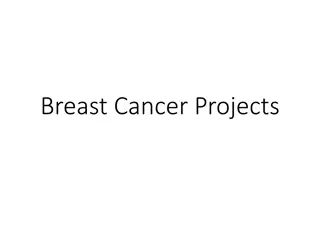Prevention of Chemotherapy-Related Heart Damage in Breast Cancer and Lymphoma Patients: PROACT Study
Dr. David Austin leads the PROACT study aiming to prevent chemotherapy-related heart damage in breast cancer and lymphoma patients using the ACE inhibitor enalapril. The research focuses on the effectiveness of enalapril in mitigating anthracycline cardiotoxicity, crucial for reducing long-term impacts on cancer survivors. The study design includes a multi-center randomized controlled trial with blinded endpoint analysis and enriched populations receiving high-dose anthracyclines. Key outcomes involve assessing myocardial injury levels and cardiac function. Disclosures indicate research grants and consultancy fees received. Follow the study on ClinicalTrials.org.
Download Presentation

Please find below an Image/Link to download the presentation.
The content on the website is provided AS IS for your information and personal use only. It may not be sold, licensed, or shared on other websites without obtaining consent from the author.If you encounter any issues during the download, it is possible that the publisher has removed the file from their server.
You are allowed to download the files provided on this website for personal or commercial use, subject to the condition that they are used lawfully. All files are the property of their respective owners.
The content on the website is provided AS IS for your information and personal use only. It may not be sold, licensed, or shared on other websites without obtaining consent from the author.
E N D
Presentation Transcript
PROACT: Can we prevent chemotherapy-related heart damage in patients with breast cancer and lymphoma? Dr David Austin Chief Investigator, PROACT Consultant Cardiologist, Academic Cardiovascular Unit The James Cook University Hospital, Middlesbrough, UK @ACUSouthTees @akaplatini
Disclosures Research grants within last 24 months: Kancera, Astra Zeneca Consultancy fees/honoraria within last 24 months: Philips Volcano
Preventing cardiac damage in patients treated for breast cancer and lymphoma: a phase 3 Randomised, Open label, blinded endpoint superiority trial of enalapril to prevent Anthracycline- induced CardioToxicity Registration: Clinicaltrials.org: NCT03265574 https://research.ncl.ac.uk/proact/
Background Anthracyclines are widely used in cancer treatment Anthracycline cardiotoxicity is dose dependent and associated with myocardial injury Prevention of cardiotoxicity is key to reducing the life-long impact of cancer treatment in the increasing population of cancer survivors The absence of myocardial injury during or immediately after anthracycline treatment has a high negative predictive value for clinical cardiotoxicity ACE inhibitors may be protective against anthracycline toxicity Aim: To establish the effectiveness of the ACE inhibitor enalapril in the prevention of anthracycline cardiotoxicity in patients with breast cancer and non- Hodgkin lymphoma (NHL)
Key design features of PROACT Multi-center randomized controlled trial Blinded end point analysis at core laboratories (PROBE design) Enriched population receiving high dose anthracyclines ( 300mg/m2 doxorubicin-equivalent) Fair test of enalapril - aimed to titrate to 10mg bd End points consistent with current understanding of anthracycline cardiotoxicity Now enshrined in ESC Cardio-oncology guideline (2022)
Blinded, Core lab assessed end points Primary end point: Myocardial injury defined as cTnT 14ng/L Secondary end points: Myocardial Injury defined as cTnI >26.2ng/L Left ventricular global longitudinal strain (LV GLS) >15% relative decline from baseline Left ventricular ejection fraction (LVEF) >10% absolute decline from baseline
Inclusion Key exclusion Adult patients due to receive 6 cycles ( 300mg/m2 doxorubicin-equivalent) of anthracycline chemotherapy Myocardial injury at baseline LVEF <50% on echo Contraindications to enalapril Already taking agents acting on RAAS EC 90 (432mg/m2doxorubicin- equivalent) FEC 75 (360mg/m2 doxorubicin-equivalent) R-CHOP (300mg/m2 doxorubicin-equivalent)
Power calculation Based on pilot data (FEC 75) and consultation with oncology, cardiology and two patient groups Assumption that 47% of patients would exhibit myocardial injury For enalapril to be considered effective, the myocardial injury would be reduced to 20% of patients At 90% power, 140 patients would be needed (plus attrition) Due to complex recruitment challenges, including COVID 19, the power was reduced to 80%, and a minimum of 106 patients (plus attrition) was required with the same assumptions
Patients with breast cancer or NHL considered Exclusions Informed consent, baseline echocardiogram and troponin Exclusions Randomization to enalapril up to 10mg bd, or usual care 1:1 Cycle 1 Cycle 2 Cycle 3 Cycle 4 Cycle 5 Cycle 1 Cycle 2 Cycle 3 Cycle 4 Cycle 5 cTnT and cTnI , <72 hours before planned chemotherapy Cycle 6 Cycle 6 Final blinded hs troponin T and hs troponin I assessment Echocardiogram
North Tyneside General Hospital, Northumbria Freeman Hospital, Newcastle upon Tyne Sunderland Royal Hospital, Sunderland County Durham and Darlington University Hospital of North Tees, Stockton The James Cook University Hospital, Middlesbrough Castle Hill Hospital, Hull Blackpool Victoria Hospital, Blackpool Clatterbridge Hospital, Liverpool Weston Park Hospital, Sheffield Royal Berkshire Hospital, Reading Kent and Canterbury Hospital, Canterbury Derriford Hospital, Plymouth Recruitment: October 2017 to March 2023
Enalapril Standard care Characteristics Key findings (n = 56) (n = 55) Demographic Age at randomization, mean (SD) Female, no. (%) Ethnicity White Non white Body Mass Index, mean (SD) Clinical history, no (%) Breast cancer Non-Hodgkin Lymphoma NYHA functional class I II ECOG performance status scale Grade 0 Grade 1 Grade 2 Coronary Heart Disease Diabetes Hypertension Current or ex-smoker Chemotherapy regimen, No (%) FEC75 EC90 (R-)CHOP 58 (11) 45 (80.4) 55 (98.2) 1 (1.8) 28.3 (4.8) 58 (12) 41 (74.5) 52 (94.5) 3 (5.5) 28.2 (5.5) Average age: 58 years old Predominantly white British, >75% female population 35 (62.5) 21 (37.5) 34 (61.8) 21 (38.2) Breast cancer 62% NHL 38% 48 (85.7) 8 (14.3) 48 (88.9) 6 (11.1) Chemotherapy regimens well balanced 49 (87.5) 6 (10.7) 1 (1.8) 2 (3.6) 5 (8.9) 12 (21.4) 29 (51.7) 48 (87.3) 7 (12.7) 0 (0.0) 2 (3.6) 3 (5.5) 5 (9.1) 18 (32.7) Received chemotherapy dose was 328mg/m2 doxorubicin equivalent Enalapril titrated to 20mg in >75% of patients, mean 17.7mg 8 (14.3) 27 (48.2) 21 (37.5) 9 (16.4) 25 (45.5) 21 (38.2)
Troponin T: primary endpoint Adjusted Odds Ratio (95% CI) P value Total n/N (%) Indicator Groups Enalapril 42/54 (78) 0.65 (0.23- 1.78) cTnT 0.405 Standard care 45/54 (83)
Troponin I: secondary endpoint Adjusted Odds Ratio (95% CI) P value Total n/N (%) Indicator Groups 25/53 (47) 24/53 (45) Enalapril 1.10 (0.50- 2.38) cTnI 0.819 Standard care
Cardiac function: LV GLS Cardiac function: LV EF Adjusted Odds Ratio (95% CI) Total n/N (%) Total n/N (%) Adjusted Odds Ratio (95% CI) Indicator Groups p Indicator Groups p Enalapril Standard care 10/47 (21) Enalapril Standard care 2/49 (4) 0.95 (0.33- 2.74) 4.89 (0.40- 674.62 0.921 LV GLS 0.236 LVEF 9/41 (22) 0/48 (0)
Key findings 81% of patients had myocardial injury on cardiac troponin T criteria 46% of patients had myocardial injury on cardiac troponin I criteria Cardiac troponin T and cardiac troponin I did not give equivalent results 21% had a >15% relative decrease in LV GLS 2% had a >10% reduction in LV EF to <50% Enalapril did not affect myocardial injury or cardiac function outcomes
Limitations Open label Challenging recruitment Included NHL patients Power 90% to 80% during COVID 19 pandemic Echocardiographic assessment at an early post chemotherapy stage further clinical and echo follow up is on going
Conclusion Adding enalapril to standard care was not superior to standard care alone in the prevention of cardiotoxicity in patients receiving high-dose anthracycline based chemotherapy
Acknowledgments PROACT trial participants Local PIs and site teams Newcastle Clinical Trials Unit Durham University and Teesside University statistics Core lab teams Trial Steering Committee Chairs: Prof Helena Earl Dr Colette Jackson Independent Data Monitoring Committee Chair: Dr Alex Lyon Sponsor: South Tees NHS Foundation Trust Research for Patient Benefit (PB-PG-0815- 20061)
